|
|
EDITORIAL: Anti-epidemic Biological Materials
YANG Yong
2023 Vol. 38 (1): 1–2
 Abstract
Abstract(
301 )
 HTML
HTML(
21)
 PDF
PDF(304KB)(
332
)
Pathogenic bacteria and viruses and cancers pose serious long-term threats to human life and health because of their quick or even explosive proliferation in the body. In particular, the global outbreak of COVID-19 in late 2019 has raised high concerns about this major public health emergency. Rapid detection, diagnosis and treatment of bacteria, viruses and cancer cells play an important role in maintaining human life and health. In addition to conventional medical diagnostic and therapeutic means, novel sensing technologies based on certain functional materials have shown promising development prospects for the detection and treatment of viruses, bacteria and cancer cells. However, the transition from novel diagnosis and treatment strategies to clinical validation still faces challenges such as biological activity, stability and reproducibility. Currently, few new technologies are actually used in clinical diagnosis and treatment. A number of functional materials, with excellent electrical, magnetic, optical and other properties, can be applied to construct biosensors with fast response, high sensitivity and high accuracy. Particularly, nanoscale materials exhibit excellent sensing properties due to their peculiar surface properties, quantum size effects and small-size effects, which can be used for therapeutic purposes through photothermal, magnetothermal and high catalytic activity with promising integration of diagnosis and treatment. With the development of nanomaterials, nano-sensing technology and biotechnology, combination of materials and medical detection are not only committed to controlling the existing large-scale outbreaks and realizing the rapid screening and diagnosis of biomolecules, but also hoped to build a universal detection and diagnosis platform to timely respond to various outbreaks and diseases. In the field of biological materials and medical detection, on the one hand, we need to consider whether the properties of a material can be affected by factors in the biological environment, such as misjudgment of results caused by interference of impurities in a personal body, and the unpredictable quenching caused by detection of substance or impurities on the fluorescence of materials. On the other hand, we need to take into account the toxicity of the material to biomolecules, the controllable and large-scale production of the material, the impact on biological barriers in the in vivo testing, and the realization of integrated diagnosis and treatment. In addition, some nanotechnologies lack specificity in nature, and biosensing technologies should consider how to construct sensing elements (including but not limited to the construction of special microstructure and functional modifications) to ensure a high degree of specificity for the target molecules. Most importantly, in order to respond to large-scale outbreaks such as COVID-19, new diagnostic and treatment technologies should be with high-throughput. In recent years, Chinese researchers have done a lot of representative work in rational design, preparation, functional modification, exploration of physicochemical mechanisms, and biomedical application of biomaterial-based biosensor technologies. To showcase the latest research achievements of Chinese scientists in the field of biomedical detection and stimulate the wide interest of all sectors of society in biomaterials and novel sensing technologies, the editorial office of Journal of Inorganic Materials invited me as the Guest Editor to organize a topical section on the theme of "Anti-epidemic biomaterials". This topical section contains the latest review articles and research papers related to the detection and diagnosis of viruses, bacteria and cancer cells, involving new biosensor technologies for COVID-19 (electrochemical sensor, SERS biosensor, SPR biosensor, etc.), fluorescence detection technology, anti-bacterial nano-enzyme technology, etc. It is hoped that this topical section will promote the cooperation of researchers and scientists from various fields with different disciplinary backgrounds, and jointly promote the innovation and development of the field of biomedical detection, with a view to changing and optimizing the diagnosis and treatment of various diseases in clinical medicine so as to better benefit human health.

|
|
|
Nanomaterials and Biosensing Technology for the SARS-CoV-2 Detection
LI Yanyan, PENG Yusi, LIN Chenglong, LUO Xiaoying, TENG Zheng, ZHANG Xi, HUANG Zhengren, YANG Yong
2023 Vol. 38 (1): 3–31
 Abstract
Abstract(
1027 )
 HTML
HTML(
51)
 PDF
PDF(13344KB)(
895
)
The outbreak of corona virus disease 2019 (COVID-19) has aroused great attention around the world. SARS-CoV-2 possesses characteristics of faster transmission, immune escape, and occult transmission by many mutation, which caused still grim situation of prevention and control. Early detection and isolation of patients are still the most effective measures at present. So, there is an urgent need for new rapid and highly sensitive testing tools to quickly identify infected patients as soon as possible. This review briefly introduces general characteristics of SARS-CoV-2, and provides recentl overview and analysis based on different detection methods for nucleic acids, antibodies, antigens as detection target. Novel nano-biosensors for SARS-CoV-2 detection are analyzed based on optics, electricity, magnetism, and visualization. In view of the advantages of nanotechnology in improving detection sensitivity, specificity and accuracy, the research progress of new nano-biosensors is introduced in detail, including SERS-based biosensors, electrochemical biosensors, magnetic nano-biosensors and colorimetric biosensors. Functions and challenges of nano-materials in construction of new nano-biosensors are discussed, which provides ideas for the development of various coronavirus biosensing technologies for nanomaterial researchers.

|
|
|
Functional Nanomaterials for Electrochemical SRAS-CoV-2 Biosensors: a Review
LIU Yao, YOU Xunhai, ZHAO Bing, LUO Xiaoying, CHEN Xing
2023 Vol. 38 (1): 32–42
 Abstract
Abstract(
416 )
 HTML
HTML(
18)
 PDF
PDF(9824KB)(
480
)
The pandemic outbreak of COVID-19 has posed a threat to public health globally, and rapid and accurate identification of the viruses is crucial for controlling COVID-19. In recent years, nanomaterial-based electrochemical sensing techniques hold immense potential for molecular diagnosis with high sensitivity and specificity. In this review, we briefly introduced the structural characteristics and routine detection methods of SARS-CoV-2, then summarized the associated properties and mechanisms of the electrochemical biosensing methods. On the above basis, the research progress of electrochemical biosensors based on gold nanomaterials, oxide nanomaterials, carbon-based nanomaterials and other nanomaterials for rapid and accurate detection of virus were reviewed. Finally, the future applications of nanomaterial-based biosensors for biomolecular diagnostics were pointed out.
|
|
|
Nanozyme: a New Approach for Anti-microbial Infections
WU Xuetong, ZHANG Ruofei, YAN Xiyun, FAN Kelong
2023 Vol. 38 (1): 43–54
 Abstract
Abstract(
706 )
 HTML
HTML(
63)
 PDF
PDF(24969KB)(
710
)
Bacteria and viruses always posed a threat to human health. Most impressively, SARS-CoV-2 has raged around the world for almost three years, causing huge loss to human health. Facing increasing challenges of drug-resistance and poor treatment efficacy, new solutions are urgently needed to combat pathogenic microorganisms. Recently, nanozymes with intrinsic enzyme-like activities emerged as a promising new type of “antibiotics”. Nanozymes exhibit superior antibacterial and antiviral activities under physiological conditions by efficiently catalyzing generation of a large number of reactive oxygen species. Moreover, enhanced therapeutic effects are achieved in nanozyme-based therapy aided by the unique physicochemical properties of nanomaterials such as photothermal and photodynamic effects. This paper reviews the latest research progress in the field of anti-microbial nanozymes, systematically summarizes and analyzes the principles of nanozymes in the treatment of bacteria and viruses from a mechanistic point of view. An outlook on the future direction and the challenges of new anti-microbial infection nanomaterials are proposed to provide inspiration for developing next generation anti-microbial nanozymes.
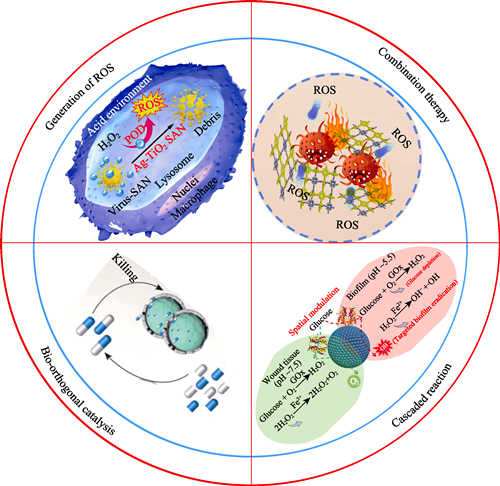
|
|
|
Construction of Prussian Blue Fluorescent Nanoprobe for Specific Detection of HClO in Cancer Cells
DU Qiujing, LIU Tianzhi, CHEN Jufeng, CHEN Hangrong
2023 Vol. 38 (1): 55–61
 Abstract
Abstract(
496 )
 HTML
HTML(
16)
 PDF
PDF(3679KB)(
497
)
Hypochlorous acid (HClO) is one of the reactive oxygen species (ROS), taking crucial parts in many physiological and pathological processes. However, excessive HClO causes tissue injuries, atherosclerosis, neurodegeneration diseases, and even cancers. Therefore, real-time detection of HClO in cancer cells is of importance for exploring the effect of HClO in tumor progression or immunotherapy. Quite different from present organic molecular probes, a novel inorganic-based hydrophilic fluorescent nanoprobe was developed by simply integrating fluorescein isothiocyanate (FITC) into hollow mesoporous Prussian Blue nanoparticles (HMPB) in this work. Owing to inner filter effect, fluorescence of FITC within HMPB quenches to some extent, which can be restored via the Fe2+-ClO- redox reaction. A typical fluorescence increase of FITC at emission peak of 520 nm can be clearly observed in the presence of HClO in vitro, which exhibits a good linear relationship in the range of 5×10-6-50×10-6 mol/L in HClO detection and its detection limit is calculated to be 2.01×10-6 mol/L. Furthermore, the cellular experiment demonstrates the specific detection capability of HClO in cancer cells with high sensitivity by the obtained nanoprobe.
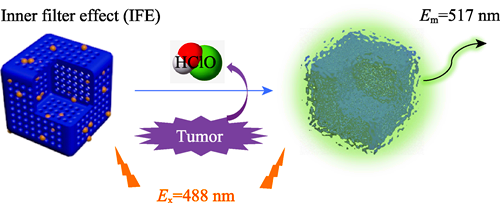
|
|
|
BiOBr/ZnMoO4 Step-scheme Heterojunction: Construction and Photocatalytic Degradation Properties
MA Xinquan, LI Xibao, CHEN Zhi, FENG Zhijun, HUANG Juntong
2023 Vol. 38 (1): 62–70
 Abstract
Abstract(
685 )
 HTML
HTML(
52)
 PDF
PDF(3476KB)(
759
)
Photocatalysis is widely used for the removal of refractory organic pollutants in water, but the catalytic activity of semiconductor photocatalysts is significantly inhibited due to the high recombination rate of photogenerated electrons and holes. In this study, an S-scheme BiOBr/ZnMoO4 composite was successfully prepared by a facile solvothermal method. The structure analysis, in-situ XPS, work function test, free radical capture and ESR experiment confirmed that the BiOBr/ZnMoO4 composite formed an S-scheme heterojunction. The experimental results show that BiOBr/ZnMoO4 heterojunction with appropriate ZnMoO4 content can significantly improve the photocatalytic performance of BiOBr. Compared with pure BiOBr and ZnMoO4, 15% BiOBr/ZnMoO4 exhibits the best photocatalytic activity under visible light irradiation, and the photocatalytic degradation rate of bisphenol A reaches 85.3% (90 min). The rate constants of photodegradation of ciprofloxacin are 2.6 times that of BiOBr and 484 times that of ZnMoO4, respectively. This can be attributed to the tight interfacial bonding between BiOBr and ZnMoO4 and the formation of S-scheme heterojunction, which enables the efficient spatial separation and transfer of photogenerated carriers. This work provides a simple and efficient method for the directional synthesis of Bi-based S-scheme heterojunction photocatalytic materials, and provides a new theory and experimental basis for further understanding of the structure-activity relationship of Bi-based multi-heterojunction photocatalytic materials.
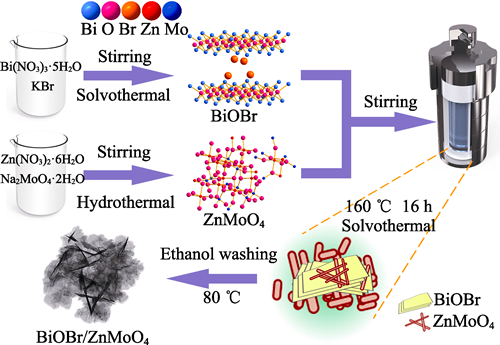
|
|
|
In-situ Loaded Pt-Co High Index Facets Catalysts: Preparation and Electrocatalytic Performance
YAO Yishuai, GUO Ruihua, AN Shengli, ZHANG Jieyu, CHOU Kuochih, ZHANG Guofang, HUANG Yarong, PAN Gaofei
2023 Vol. 38 (1): 71–78
 Abstract
Abstract(
381 )
 HTML
HTML(
22)
 PDF
PDF(7682KB)(
525
)
Direct ethanol fuel cell (DEFC) has been widely studied because of its advantages of easy fuel availability, green and high effiency. However, DEFC catalysts are still frustrated with low catalytic efficiency and poor catalyst stability, which restrict its rapid development. In this work, XC-72R carbon black-loaded Pt1Cox/C high-index crystalline nanocatalysts were prepared in one step by liquid-phase hydrothermal synthesis, using polyvinylpyrrolidone (PVP k-25) as dispersant and reducing agent, glycine as surface control agent and co-reducing agent, and modulating the molar ratio of Pt-Co metal precursors to achieve the in-situ growth of catalyst particles on carbon carriers. The exposed high index crystalline facets of the Pt1Co1/3/C nanocatalyst mainly consisted of (410), (510) and (610) crystalline facets. The growth pattern of the Pt1Co1/3/C nanocatalyst grains varied from 'sphere-like' to cubic, and eventually to concave with high index grain orientation. The Pt1Co1/3/C nanocatalyst with high index crystalline surface has the highest electrocatalytic activity with an electrochemically active surface area of 18.46 m2/g, a current density of 48.70 mA/cm2 for the ethanol oxidation peak, a steady state current density of 8.29 mA/cm2 and a potential of 0.610 V for the CO oxidation peak. This indicates that the defect atoms such as steps and kinks on the surface of the catalyst with high index crystal plane can increase the active sites, thus showing excellent electrocatalytic performance. This study may provide a theoretical basis for the development and industrial application of high index crystalline catalyst materials.
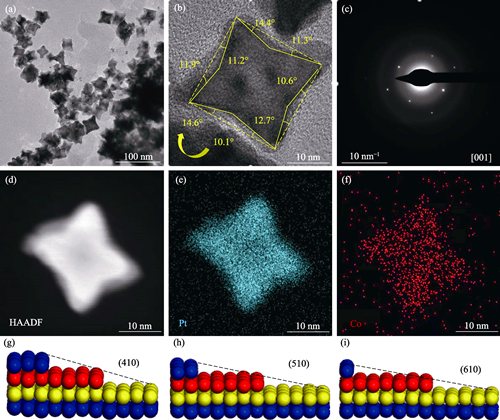
|
|
|
NH4+ Assisted Interlayer-expansion of MoS2: Preparation and Its Zinc Storage Performance
LI Tao, CAO Pengfei, HU Litao, XIA Yong, CHEN Yi, LIU Yuejun, SUN Aokui
2023 Vol. 38 (1): 79–86
 Abstract
Abstract(
505 )
 HTML
HTML(
27)
 PDF
PDF(1847KB)(
534
)
Suffering from strong electrostatic interactions between divalent Zn2+ and host framework, molybdenum disulfide exhibits slow reaction kinetics as cathode for aqueous zinc-ion batteries. The narrow layer spacing of MoS2 is difficulty in accommodating large size insertion of hydrated Zn2+, resulting in a lower discharge specific capacity. Here, NH4+ expanded MoS2-N was prepared by a simple ammonia-assisted hydrothermal. The result showed that the ammonia promoted hydrolysis of thioacetamide to provide reduced S2- and generated a large amount of NH4+ as intercalating particles. These particles expanded the layer spacing of pristine MoS2 from 0.62 nm to 0.92 nm, greatly reducing the Zn2+ inserting energy barrier (with its charge transfer resistance of MoS2-N only 35 Ω), and increased the discharge specific capacity to 149.9 mAh·g−1 at the current density of 0.1 A·g-1, 2 times that of MoS2 electrode without NH4+ expansion. Consequently, it exhibited a stable discharge capacity of about 110 mAh·g-1 at the current density of 1.0 A·g-1 with nearly 100% Coulombic efficiency after 200 cycles. The approach of ammonia-assisted layer expansion proposed in this study enriches the modification strategy to enhance the electrochemical performance of MoS2 and provides a new idea for subsequent cathode development.
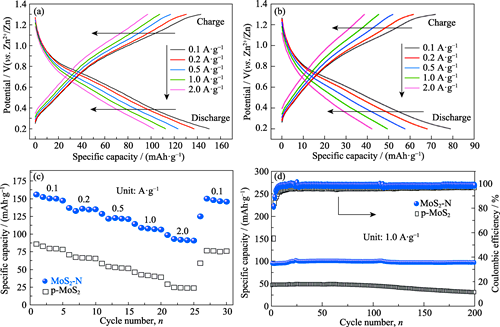
|
|
|
p-n Heterostructured BiVO4/g-C3N4 Photoanode: Construction and Its Photoelectrochemical Water Splitting Performance
WANG Ruyi, XU Guoliang, YANG Lei, DENG Chonghai, CHU Delin, ZHANG Miao, SUN Zhaoqi
2023 Vol. 38 (1): 87–96
 Abstract
Abstract(
403 )
 HTML
HTML(
29)
 PDF
PDF(2396KB)(
471
)
Bismuth vanadate (BVO) can be used for photoelectrochemical (PEC) water splitting to hydrogen. However, suffering from its high charge-recombination and slow surface catalytic reaction, the PEC performance is far below the expectation, and the modification of the co-catalysts only on the electrode cannot overcome this disadvantage. Here, we report FeNiOx cocatalyst decorated on the BVO photoanode, which can restrict the onset potential and improve the PEC performance. Moreover, a more effective dual modified-BVO photoanode is formed, with the loading of g-C3N4 before decoration of FeNiOx cocatalyst. The type-II p-n heterojunction composed by g-C3N4 nanosheets and BVO, can inhibit recombination of photogenerated charge, and promote the separation of charge effectively at the electrode. Results show that the charge separation efficiency of the electrode reaches 88.2% after the insertion of g-C3N4, which is nearly 1.5 times that of BVO/FeNiOx (60.6%). Moreover, surface charge injection efficiency of the dual-modified BVO/g-C3N4/FeNiOx electrode reaches 90.2%, while the current density reaches 4.63 mA∙cm-2 at 1.23 V (vs. RHE). This work provides a facile approach to develope high performance photoanodes for PEC water splitting.
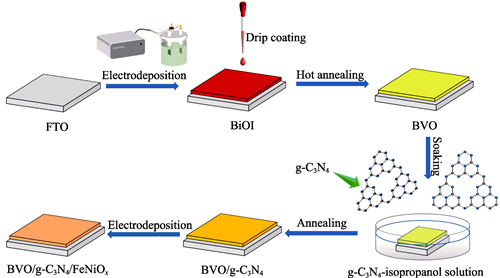
|
|
|
Luminescence Property of Eu Doped SiAlON Phosphors for White LEDs
LU Chenhui, GE Wanyin, SONG Panpan, ZHANG Panfeng, XU Meimei, ZHANG Wei
2023 Vol. 38 (1): 97–104
 Abstract
Abstract(
446 )
 HTML
HTML(
23)
 PDF
PDF(5908KB)(
442
)
SiAlON-based phosphor has become a research hotspot due to its excellent chemical and physical stability. Especially in the LEDs field, it has received extensive attention in recent years. Rare earth doped SiAlON phosphor is expected to become a new generation of lighting source. However, due to the lack of cyan light emission, the color rendering performance of white-LED (wLED) is often insufficient. In this research, β-Si5AlON7:Eu phosphors were synthesized by the traditional high-temperature solid-state route. The structure, morphology, elements and valence states were examined. The wavelength range of excitation spectrum and emission spectrum of Si5AlON7:Eu, as well as the thermal quenching performance were studied. It is found that the excitation wavelength range covered the ultraviolet to blue region, and the emission spectrum is a typical broad feature of Eu2+ transition. At 300 ℃, the emitted light intensity of the sample can still reach about 40% that of the room temperature, while the thermal activation energy (Ea) reaches 3.7 eV. Compared with the commercial YAG:Ce3+ (YAG) phosphor, the thermal stability of Si5AlON7:Eu is improved. The wLED with high color rendering of Ra=87 is realized after compounding with the blue chip, and the corresponding color temperature reaches the warm white light range (CCT=4501 K). In this study, SiAlON-based cyan emission is realized, and the phosphor with excellent thermal stability is obtained. Compared with commercial YAG, it also has obvious advantages in the sustainability of luminescence.
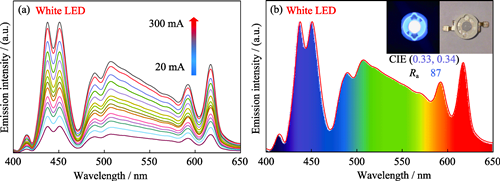
|
|
|
High Temperature Long-term Service Performance of TiAlCrY/YSZ Coating on TiAl Alloy
PAN Yangyang, LIANG Bo, HONG Du, QI Zhixiang, NIU Yaran, ZHENG Xuebin
2023 Vol. 38 (1): 105–112
 Abstract
Abstract(
437 )
 HTML
HTML(
24)
 PDF
PDF(17461KB)(
539
)
TiAl alloy has excellent properties of low density and high specific strength, which is a potential structural material for aero-engine. The service temperature of TiAl alloy is limited in the range of 700-900 ℃, which is further improved by preparation of high temperature thermal protection coating. In the present work, a new type of TiAlCrY/YSZ coating was prepared on the TiAl alloy by plasma spray technologies, of which long-term service performance at high temperature was compared with the traditional NiCrAlY/YSZ coating. It was found that the TiAlCrY/YSZ coating remained intact after served 300 h at 1100 ℃ in the air, showing excellent high temperature performance, while the service lifetime of the NiCrAlY/YSZ coating at 1100 ℃ was less than 100 h. The microstructure observation found that a continuous and dense TGO composed of Al2O3 was continuously formed on the TiAlCrY bonding coating, suggesting that TiAlCrY coating has good interfacial compatibility with the YSZ top coating. Moreover, the thickness of TGO was still less than 8 μm after served 300 h at 1100 ℃ in the air. As compared with traditional NiCrAlY/YSZ coating, the TiAlCrY/YSZ coating is a more suitable high temperature thermal coating ever for TiAl alloys.
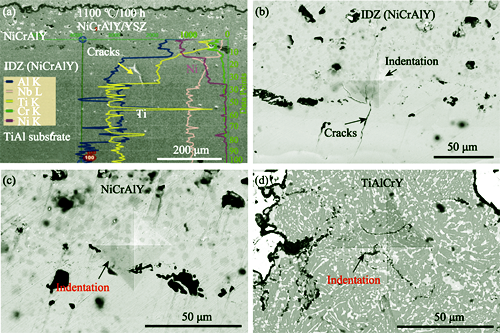
|
|